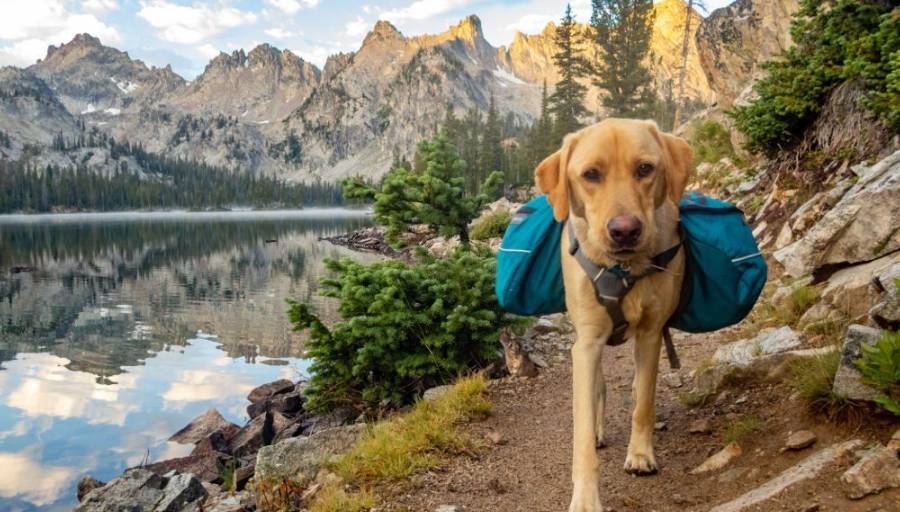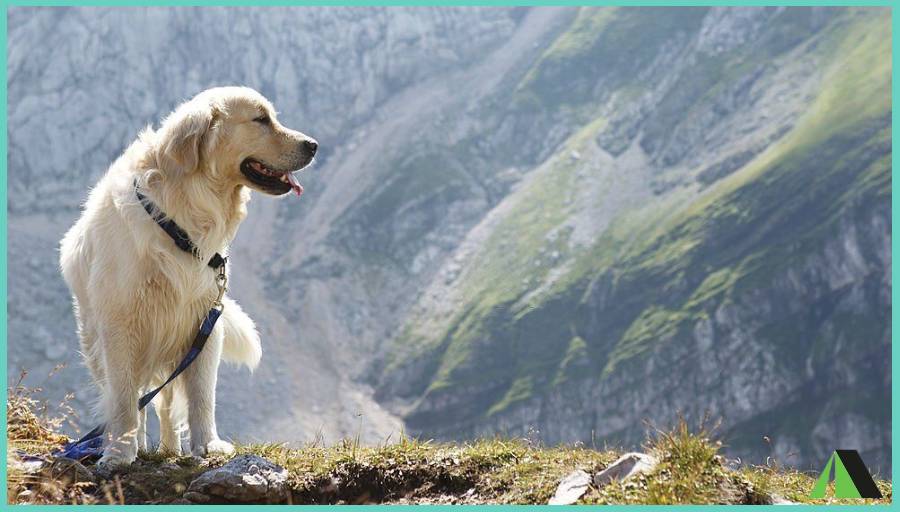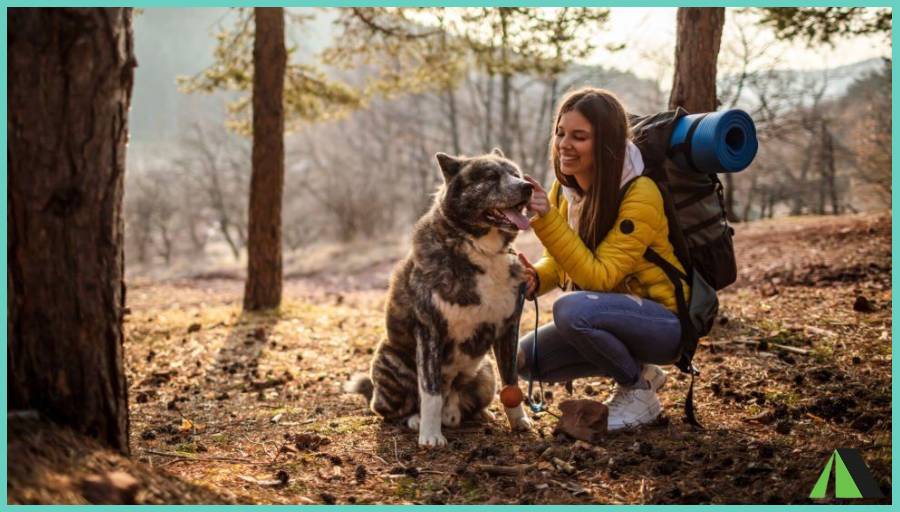
We are frequently tempted to bring our canine companion along when venturing into the great outdoors for a hike. We convince ourselves that allowing our dogs to roam in the forest or along the seashore would be beneficial, providing an opportunity for them to stretch their legs and enjoy the natural surroundings.
However, caution is essential, as not all dogs possess the same physical and cardiorespiratory capacities. Undertaking a 10-kilometer hike might be too strenuous for some of our beloved companions. Before embarking on a hiking adventure with our dogs, it is crucial to thoroughly understand what steps to take and, equally importantly, what to avoid—both before, during, and after the walk.
Hiking With Your Dog: Things Not to Do
Before learning the essential steps to ensure an optimal hiking experience with your dog, let’s first highlight what you should absolutely avoid doing!
To begin with, refrain from taking your dog on a hike if they are not accustomed to it. In other words, initiate the hiking experience with shorter walks lasting an hour or two before attempting a more demanding trail. Just like with humans, your dog’s capacity to handle a hike will improve with gradual training.
Likewise, you must accustom him to being assaulted by a multitude of sensory stimuli. Unlike the city, the countryside or the forest are places loaded with intense perfumes, intense sounds, and movements from all sides. If he is not used to it, your dog will be overwhelmed by these stimuli and will start not to listen to you anymore. In simpler terms, the things to avoid when hiking with your dog are quite similar to those when embarking on a solo hike—mainly, neglecting proper preparation!
Hiking with Dog: What to Do
Hiking with a dog is not an innate skill; it’s a physical activity that can be learned and, most importantly, requires thorough preparation. To achieve this, various gestures and strategies need to be implemented before, during, and after the hike. Focus on these fundamental points!

Before the Hike
We have just seen it, your dog will have to undergo training to be able to practice hiking. Don’t forget that if you go 10 kilometers, your dog goes 20! When you walk, he will start scampering and pacing back and forth. Good preparation is therefore the essential starting point for a successful hike with your dog. But not only! As usual, preparing your route and providing supplies, such as water and food, is also mandatory.
Also remember to abandon the technical passages of certain routes, such as climbing or the steep passages that we talked about in our article dealing with the most dangerous hikes in the world. Even if you feel able to overcome these obstacles, your dog (quadruped by nature) will not be able to do so. So learn to imagine the course as if you were your own dog. What places would you have trouble with? If you find them, eliminate them.
There is also another type of problem that can arise when hiking with your dog. Some natural areas are forbidden to dogs that are not kept on a leash! You should find hiking trails around you.
Finally, to find equipment adapted to the morphology of your best friend and his physiological needs, it is necessary to prevent the risk of losing him. Because, yes, it happens every year that dogs ill-prepared for wild spaces get lost! To prevent this, you can chip your dog with a GPS tracking tag directly from your veterinarian.
If the concept of implanting a tag under your dog’s skin is unsettling, it’s worth noting that alternatives are available, such as collars with the owner’s telephone number or tags with your contact details that can be attached to their collar.

During the Hike
Now that your dog has undergone training for hiking over several days and has become accustomed to natural environments, it’s time to transition to the actual day of the hike. Let’s see what aspects to watch out for and what actions to take during the hike:
- Excessive temperatures: although it is covered with hair, your dog may have difficulty tolerating the cold. Here, it will be on a case-by-case basis. While a husky will have no trouble hiking in freezing temperatures, other breeds may be more susceptible. Conversely, hot days can be dangerous for your dog if he is not used to it. When dealing with extreme temperatures, it is crucial to monitor and prevent the onset of heatstroke, dehydration, or hypothermia in your dog.
- Your dog’s state of fatigue: even with good training, a dog can experience more difficult days than others, like us! So be careful not to set too high a pace to allow him to follow you without difficulty.
- Hydration: While a dog’s digestive system is better equipped than ours, allowing them to drink water from most rivers or lakes, there are instances where this may not be sufficient. Some trails might lack accessible water points, so it’s important to remember to offer your dog water regularly during the hike.
- Food: Large dogs, such as German Shepherds, Huskies, and Labradors, among others, have difficulty combining physical activity and food intake. This can cause stomach upset in these animals. To avoid this problem, only feed your dog when you have reached the evening stage, i.e. after the day’s walk. If he’s really hungry during the day, give him a snack during the lunch break.
- The dangers of fauna: certain wild or even domesticated animals can represent a danger for dogs unaccustomed to crossing other species. This is particularly true in areas where vipers are present, as their bites can be fatal for dogs. Also, encounters with deer or wild boars pose a risk, as these animals may defend themselves, potentially leading to harm to your dog. In the mountains, ibexes and chamois are sure-footed and risk taking your dog to the edge of the cliff. Still in the mountains, the Patous, these dogs that guide and protect the herds, can represent a threat if your dog is aggressive with one of the animals he protects. In short, be vigilant about the propensity of dogs to pursue a fleeing animal!
- Fall hazards: In theory, having four legs and a lower center of gravity should be a significant advantage for your dog on the trails. However, it’s important to pay attention to its behavior, especially in high-altitude environments. In challenging or precarious passages, don’t hesitate to harness your dog for added safety and control.

Things to Do After the Hike
Similar to any hiker, your dog requires proper nourishment, hydration, and rest after a long day of walking. Here are some evening care tips to ensure your dog’s well-being:
- Give him food and drink: the quantity varies according to your dog’s morphology, so it’s up to you to know him well to help him as best you can!
- Checking his pads: A human can develop blisters on his foot while hiking, but a dog can also injure his paws. Stony paths can cause cuts that you will need to treat as quickly as possible so that they do not become infected. Also check for needles, broken glass, or splinters. Finally, be vigilant near the places where the flints are exposed because these stones are as sharp as razors!
- Check for ticks: for both humans and dogs, beware of ticks and Lyme disease when hiking! Take a good look at his hair. If you find any, remove it with a suitable tick remover.
- Check its tongue: Processionary caterpillars, which live in pine trees, have microscopic poison-coated spikes that can get caught in dog hair. When it is infested with them, it will have the reflex to lick itself to remove them. Unfortunately, this will result in infecting the tongue and causing it to swell! If you notice this type of problem, you absolutely must take your faithful friend to the veterinarian.
- Install a cozy nest for him: before sleeping, be sure to dry his hair and place him in a dry place (sheltered from the wind), so that he does not get sick. Also, remember to make him a cozy place for the night so that he can recover easily!
Useful Equipment for Dog Hiking
In the realm of hiking, there is specialized equipment designed to cater to the needs of dogs of all breeds. This not only helps prevent potential dangers but also ensures the well-being of your canine companion throughout the journey. Let’s take a look at the various possibilities available to you:
The Attachment Material
Keep in mind that during your hikes as during any walk, you remain responsible for the actions of your dog! As we have seen, in some Regional Natural Parks, you will have to keep it on a leash. Here are 3 attachment options for your dog that are suitable for dog hiking:
- Traditional leash: it is ideal for one-hour hikes. It is not very comfortable for your dog when he wears it for hours. Also, he may give him neck pain from pulling on it.
- Dog harness: the dog harness is very interesting for hiking with dog! Tied around the canine’s shoulders and back, it does not tire it out too much. Besides this, you can connect it directly to you with a waist belt!
- Harness with packsack: This is perfect for hikes lasting several days, but only for large dogs. These are generally the same harnesses as the previous ones but with an additional bag that your dog will carry himself, like a donkey. But be careful because a dog is not an animal known to carry heavy loads! Note that he can carry 25% of his own weight at most and over short distances, even if he is trained.
Food, Water and Well-Being
In the packsack, you will be able to place your dog’s food and water. Get him used to carrying such a bag from a very young age. Otherwise, you will have great difficulty teaching him later. Besides these basic necessities, you can also think of some objects and tools that will allow you to live a fabulous time.
So that he can eat or drink easily, you can take two collapsible silicone bowls. Light and easy to store, they will allow you to pour water and food during breaks. For transporting water for your dog, hiking water bags are very practical.
Regarding safety and health, the tick remover is mandatory. It will certainly be useful for your dog as well as for you. Addressed during training, the recall whistle (also known as the ultrasonic whistle) can quickly become imperative on hiking trails.
Finally, in terms of well-being, pad shoes can be a good purchase if your dog is particularly sensitive to this part of the body or if you walk on hard ground. Don’t hesitate to bring the usual brush to remove the mud or plant debris accumulated during the day. If he particularly likes to jump into the water when he has the opportunity, a towel to wipe him will also be necessary!
If you are going on a multi-day hike and are planning to camp, remember that your dog also needs comfort to regain strength. A small mattress and a blanket are solutions not to be neglected in this case. In any case, don’t lose sight of the importance of taking a survival blanket on a hike!
Hiking with Dog: FAQs!
How many kilometers can my dog hike?
Your dog may fall into one of two groups. The first group comprises active dogs that are accustomed to regular hiking and can cover long distances, typically ranging from 20 to 30 km per day. The second group consists of dogs that are not accustomed to extended walks, and you can anticipate them covering distances of up to 16 km per day.
Do dogs get hurt when hiking?
Your dog may not look exhausted after a hike, but he’s probably sore. If your dog is not used to hiking, he will feel pain. Their muscles are like ours! If you exercise him too much, he may get hurt.
Can I take my puppy on a hike?
Check with your veterinarian before taking your puppy on a hike. You’ll want to wait until he’s at least 16 weeks old and fully vaccinated before you go hiking, as a curious puppy is bound to be interested in things like animal droppings and other animals.
What signs indicate my dog needs a break?
Heavy panting, excessive drooling, lagging behind, or reluctance to continue may indicate fatigue. Take regular breaks and monitor your dog’s behavior.
Is it safe to let my dog off-leash during a hike?
It depends on the trail and local regulations. Ensure your dog has reliable recall, and be mindful of other hikers, wildlife, and potential hazards.
The verdict
Unlike walking, hiking with your dog cannot be improvised overnight. Like humans, our dog friends need regular training to get their bodies used to this new effort. They must also get used to being bombarded with new smells and noises. For this, progressive training and a good education are keys to a successful hike. During these expeditions, he will sometimes have to be kept on a leash. Your dog will be free and will often do twice the number of kilometers compared to you!
You will therefore have to take care that he does not tire too quickly. Multiply the breaks and make sure that he drinks regularly. In the evening, brush it, and check that it has no ticks or that its tongue does not swell due to bites from processionary caterpillars. Give him food and make him a cozy place where he can regain his strength by your side.
Hiking with your dog in complete safety is indeed possible when you adjust the route and pace to your abilities, not just yours alone. By adhering to this fundamental principle, no long trail will be too challenging for you and your canine companion to conquer!